Thankfully, it is not our job to develop a product that satisfies humankind’s seemingly innate attraction to glossy surfaces. There are more than enough contenders in that category.
For example, take bottled boat waxes, which we last reported on in the February 2009 issue. Soon after we asked readers to suggest bottled waxes and polishes for testing, we had a list of more than 25 products. These ranged from the latest formulas made by chemical giants to quaintly packaged mom-and-pop concoctions. (Skeptics that we are, we often suspect that many
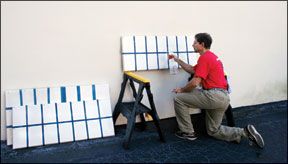
288
of these products are nearly identical formulas.) This month, we take a look at these same bottled waxes after six months in the Florida weather. At this point, we hope to find out once and for all whether it really is worth paying more for a premium bottled polish.
What We Tested
As it turns out, comparing bottled polishes isn’t much easier than explaining what causes a surface to appear glossy or why this appearance is so appealing. First, there is the business of defining a wax/polish. As we found in our recent comparisons of canned paste waxes (February and July 2009), only a handful of so-called waxes still contain a significant quantity of natural wax in their formulas. Nevertheless, the label “wax” persists, if only for convenience.
Most of the products in this comparison are liquid polymers. All come in a bottle dispenser. Bottle application, either by squeeze-top or spray, is generally faster, but it’s important to thoroughly mix these products before applying. Our past tests found that bottled waxes generally do not protect as long as the best canned paste waxes, and this still seems to hold true, although we did find some exceptional products in this test that may compete with our top recommended pastes: Collinite No. 885 Heavy Duty Fleetwax Paste and 3M Ultra Performance Paste Wax.
Like our paste waxes, these liquid products are designed to be the final protective layer applied to a new boat or to an old boat that has been thoroughly compounded and polished to a smooth, shiny finish. Applying these products to an oxidized hull will not achieve the best results. For a complete look at the steps to protecting older gelcoat, see our online article at www.practical-sailor.com/tools/
gelcoat_maintenance.html.
If your main goal is simply to protect your hull from further UV damage and make it easier to clean, consider a one-step cleaner-wax (February and November 2007). The products in our 2007 test delivered a decent shine with very little effort and provided up to 12 months of topside protection in Florida.
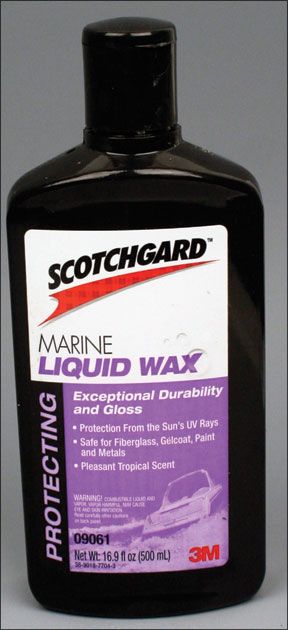
149
The best product in that test was Star brite’s One Step Heavy Duty Cleaner Wax. However, two relatively new products are doing well on our current test panel: Woody Wax XXX Cleaner Wax paste wax (www.woody-wax.com) and Mother’s Marine Cleaner Wax (www.
mothersmarine.com).
How We Tested
For testing liquid waxes, two 3-by-5-foot, white fiberglass hatch covers were washed, dried, and then prepared by machine buffing with 3M Perfect-It rubbing compound and the micro-finishing compound 3M Finesse-It II Restorer to remove scratches. A few products specified using only their own micro-finishing compounds, which testers used accordingly. Each coating was applied as directed to a taped-off section about 6-by-8 inches big and then hand-buffed. Although several products recommend multiple coats, testers applied only one coat of each product for testing.
In blind testing 24 hours after application, evaluators rated each panel in the sunlight, then sprayed them with a mist of water and rated the relative beading. In a dark room, testers held a multi-bulb LED flashlight over each polished square to rate gloss. The degree of clarity of the reflected LEDs in each square determined the finish’s degree of gloss.
After the application and initial ratings, testers mounted the hatch covers face-up in an unobstructed spot on the roof of our workshop in Sarasota, Fla., leaving them to bask in the hot
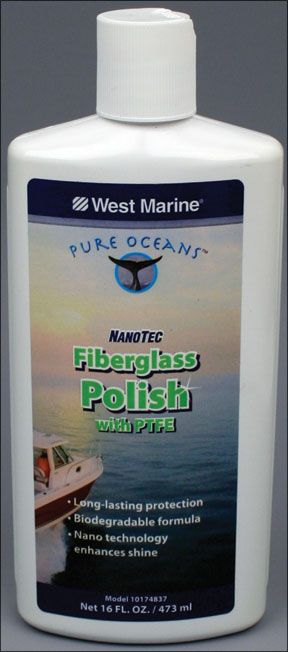
144
sun, wind, and summer rain. After six months, the panels were again rated for gloss and also were rated for stain resistance by seeing how easy it was to wipe away a dried tea stain, which is similar to the tannin stains that plague waterlines of boats on the Intracoastal Waterway. (See Value Guide, page 14, for ratings.)
Marine Polishes with Petroleum Distillates
Tighter environmental restrictions have led to a new generation of automotive and marine polishes that contain no volatile organic compounds (VOCs) or petroleum-based products. However, most of the products in our test still contained petroleum distillates, used primarily for their surface cleaning powers. None of the tested products advise wearing protective clothing, but after poring over the manufacturers’ safety data sheets (MSDS) for these products, we recommend wearing gloves and working in a well-ventilated area.
Preserving the gloss of a porous gelcoat offers special challenges, so it is not surprising that some of the best performing products were designed primarily for gelcoat surfaces. Although the 3M Scotchgard Marine Polish didn’t stand out for its gloss upon application, its ability to bead water at the six-month mark was exceptional. It was clearly better at resisting stains and beading water than its nearest contender, Star brite Premium with Teflon, our top pick for initial gloss. Collinite’s No. 845 Heavy Duty Insulator Wax also produced well-defined water beads at six months. This product, initially developed to protect insulators on utility power lines, is the same formula as the Collinite No. 925 Fiberglass Boat Wax. It did not resist stains as well as others in the test.
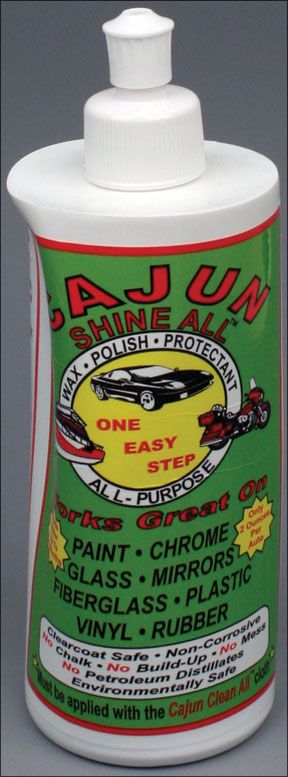
120
At about $30-plus for 16 ounces, all of the best performing products are fairly expensive. If you’re looking to spend less than $20, then the Yacht Brite Pro Polish, which did nearly as well as our favorites, is a good choice.
Bottom line: Of all the tested products, the 3M Marine Polish was unanimously rated highest for water beading and repelling stain best after six months. Its overall gloss rating was slightly lower than the Star brite Premium and Collinite No. 845, both of which also delivered very good overall performance.
‘Green’ Polishes
Given the marketing frenzy surrounding “green” products, we were surprised to find so few products without petroleum distillates. West Marine’s Pure Ocean’s Fiberglass Polish, a wipe-on product called Cajun Shine All, and Re-Structure Marine’s Professional Marine Polish were the only products that met this criterion. (We did not evaluate any other environmental claims.)
West Marine’s “nanotech” Fiberglass Polish, which uses a citrus-based cleaner and produced an above-average gloss, earned a recommendation for this category—and the price is right. Given its low viscosity and primary target (automobiles), Cajun Shine All showed surprising durability on our polished gelcoat. One of the easiest products to apply and one of the few you can use on plastic, it also resisted stains well.
Restructure Marine’s Professional Polish, which claims multi-year protection and has performed exceptionally well in previous tests, did not impress testers at the six-month mark. (Since this test started, Restructure has reformulated its polish.)
Bottom line: As a group, the “green” polishes didn’t rank at
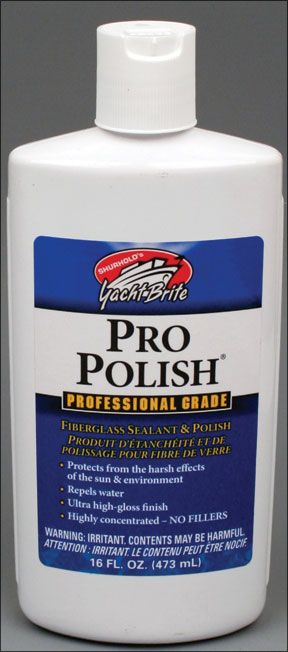
144
the top, but they offer a good alternative for people who don’t like to work with petroleum-based products. Using citrus-based cleaners, the Pure Oceans polish seemed the most effective, although the Shine All’s ease of application and stain resistance makes it an attractive option.
Auto Polishes
Several readers recommended their favorite automotive polishes for testing, and although many of these products, such as Zaino Z-3 Show Car Polish, ranked high for their initial gloss, they didn’t hold up as well in the long run. One exception was Mirage, a multi-surface cleaner-polish and sealant for boats, cars, trucks, and more. The maker, Illinois-based MP Pros, also makes Prism Polish, a multi-purpose polish that has fared well in metal-
polish tests (March 2007).
The liquid Nu Finish, recommended by several readers, didn’t seem to have the same durability of the paste wax version that we reported on earlier this year. Nevertheless, its above-average performance—particularly in stain resistance—and rock-bottom price earned it a Budget Buy pick.
Bottom line: While these multi-purpose products lagged behind the top polishes in this comparison, they make sense for someone looking to save shelf space. Both Nu-Finish and Mirage proved very effective at repelling stain. Despite makers’ claims, we would not recommend these for an LPU-painted hulls without approval from the paint manufacturer.
Expensive Treatments
Two products, Island Girl Mirror Hard Superglaze and Glare Professional Polish, stood out for their high per-ounce price. Both products also claimed distinctive chemical properties and called for slightly unusual application techniques. Although neither could be considered acrylic products like those that Pracical Sailor reported on in September 2009, they make similar claims regarding durability.
One of many unique products made by Hawaii-based Island Girl, Mirror Hard Superglaze is a two-part product designed to be wiped on to a new gelcoat surface or waxed surfaces, (preferably one that has been waxed by Island Girl Superwax). The maker claims up to three years of water beading in the tropics. So far, the Mirror Hard Superglaze is holding up very
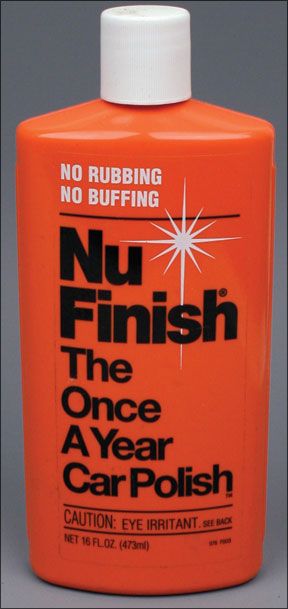
154
well in our test, lagging slightly behind more conventional waxes in its stain resistance.
Aimed primarily at car show enthusiasts, Glare Professional Polish is described as a flexible, non-stick sealant. Its proprietary formula, called Glassplexin, contains no waxes, polymers, or resins. According to the maker, protection for autos can last up to five years. Although its initial gloss was good, it neither beaded water nor resisted stains well after six months, compared to other products in our test.
Bottom line: It’s too early to tell whether Island Girl is worth the expense. Glare clearly is not, at least not for gelcoat surfaces.
Conclusions
Based on near unanimity during the ratings process, we feel confident in our recommendations for liquid waxes after six months. Either one of the two top products in our test, Scotchgard Marine Polish or Star brite Premium, will provide maximum protection in this category. Collinite’s 885 Insulator Wax (or No. 925 Fiberglass Boat Wax) is a good third choice. A less-expensive equivalent would be Yacht Brite Pro Polish.
If you want to avoid petroleum-based products, West Marine’s Pure Oceans Polish is a good choice. Opt for the Cajun All or the Mirage if you’re looking for an all-purpose product that will also work on your car. The rock-bottom budget liquid is Nu Finish. Island Girl may well live up to its long-term claims, but it’s too early to tell.
Although these bottled waxes definitely speed the application process, the beading at six months does not match what we’ve seen in the best paste waxes, like Collinite No. 885 Heavy Duty Fleetwax or 3M Marine Paste Wax. If you can put up with the extra elbow grease, or are handy with a variable-speed polisher, these hard pastes seem to deliver a harder finish and longer-lasting results. Look for a head-to-head, liquid vs. paste wax all-stars test in the future.


































If there are products that last longer that 6 months, why is there no commentary for them? Island Girl claims to last up to 3 years, yet you do not comment. Why is that? I use the product and find it has lasted at least 3 yrs in Florida sun. What review do you have?
We’ve tested several Island Girl products. You can find them by searching “Island Girl” in the search bar. Here’s one report.
https://www.practical-sailor.com/boat-maintenance/paints/a-year-later-liquid-wax-test-results-2010
Does 3M prevent water spots from appearing?